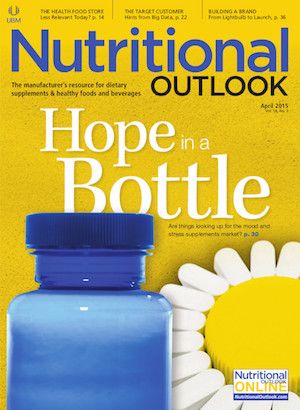Who Is the Dietary Supplement Shopper Today?
What does Big Data show about dietary supplement shoppers?

Is there a singular supplement shopper out there? No, to an extent. As Michele Michielini, senior director of consumer insights, NBTY Inc. (Ronkonkoma, NY), points out, “There really isn’t a ‘typical’ supplement shopper. Shoppers vary based on many factors, including gender, age, income, and individual need states-such as those trying to support heart health or eye health.”
If drawing a fine bead on the target consumer seems a daunting task, that’s because it is. But with Big Data in hand, today’s supplement marketers do know more about who their customer is. Nutritional Outlook spoke to a few industry experts who shared their insights on just what’s trending in the supplement world-and with whom.
It’s My Generation?
The Council for Responsible Nutrition’s (CRN; Washington, DC) 2014 Consumer Survey on Dietary Supplements1 revealed a clearer demographic sorting of supplement-use patterns. Michielini says that though the survey found equally high multivitamin use among all age groups, for instance, “‘specialty’ supplements skewed more toward elders-age 65-plus-while sports nutrition and weight management skewed more toward Generations X and Y.”
Mature shoppers-those born before 1945-“are more oriented toward supplementation for specific issues,” agrees Steve French, managing partner, NMI (Natural Marketing Institute; Harleysville, PA), sharing insights from NMI’s Supplements/OTC/Rx Database, a survey of 2,300 general-population adults in the United States. Omega-3s appeal to these folks concerned about heart health, and glucosamine gains traction with those tending to aching joints. As for Baby Boomers, French says, “They index high for antioxidants and probiotics as well as joint health and cholesterol.”
Then there are the Millennials, whose impact on the industry could be as significant as it is on society at large. According to French, between 2009 and 2013, supplement use increased among all generations, but Millennials showed the largest growth. For Millennials, the share of those who used a supplement in the past 30 days rose from 50% in 2009 to 68% in 2013.
Millennials have upped their average intake more than other generations, too, going from 1.8 supplements per day in 2009 to 2.8 just four years later. And as for which supplements they’re turning to, French points to “a wide array of supplement categories, including single vitamins and minerals, herbals/botanicals, condition-specifics, homeopathics, and ayurvedics.” Versus the general public, Millennials index high for antioxidants and energy supplements and are also more likely to take supplements for detoxification purposes.
Today’s youth-driven infatuation with social media also influences supplement choices, with 18% of all supplement users and fully 45% of Millennial users giving social media some credit in swaying purchase decisions.
The Gender Gap Is Closing?
Gender gaps still persist among supplement shoppers, who still by and large are women. (Both NMI’s database and the CRN consumer survey confirm this fact.) “Women are significantly more likely to be heavier users,” French says, because women tend to be more proactive in maintaining health overall.
But NBTY’s Michielini notes that in the three years between the latest CRN survey and the survey the year before, that gap shrank, as purchases by “women directionally declined from 74% to 71% and men increased from 62% to 65%.”
Socioeconomic Factors
While supplement usage patterns track more closely with education than income-32% have at least a college education, and median user income is $63,900, per NMI numbers-“the economy has impacted supplement purchases,” French concedes. As Michielini notes, supplements are often discretionary purchases, “so if a family needs to make a choice between a necessity-food, for example-or a supplement, the food, of course, takes priority.”
Seeking Food First
That may not be the only case in which food takes priority. “Consumers overwhelmingly prefer to get nutrients from the foods they eat rather than take a supplement in pill form,” French says. Indeed, the percentage in this camp rose recently to 60% from 54% in 2011.
But this preference hasn’t upended the supplement market, Michielini insists. The emergence of functional foods and beverages-not to mention novel supplement delivery options-may have actually broadened supplements’ audience. “Functional foods have certainly been successful in providing consumers with a variety of alternate means of ingesting certain nutrients,” she says. “Making these nutrients available in other forms allows for a more convenient way to consume them.”
NMI’s database bears this opinion out, with 38% of Millennials and 35% of “energy managers” driving the fortified-beverage and shot market, French says. And the increase in preference for alternative formats from 2009 to 2013 pans out thusly: soft gels up from 30% to 37%, chewables from 22% to 26%, and soft chews from 18% to 24%. Other alternative formats with more stable growth include liquid-filled capsules at 28%, gummies at 22%, liquid at 18%, fast-dissolve tablets at 18%, nutritional bars at 16%, and ready-to-drink beverages at 16%, he adds.
Wellness Overall
If there is one commonality broadscale supplement users share, it is that they take supplements for overall health and wellness. No wonder so many see even the good ol’-fashioned multivitamin as a “nutrient ‘insurance policy,’” as French says. “Self-responsibility for health is high as consumers look to take back control of their own health,” he says. Tellingly, NMI’s research says that 83% of the general public claims to be “taking more responsibility for their health” than the percentage that made that claim 10 years ago.
Even better, the past half-decade has seen more supplement users believing that they can manage their health issues through supplementation, “revealing a stronger integration of supplements into maintenance of a healthy lifestyle,” he continues. To strengthen that integration even further, keep the communications clear to “help consumers sort through any confusing media messages and help boost loyalty and compliance to a specific supplement,” he advises.
And remember that the more we plumb the data and the better we get at turning it into actionable knowledge, the more empowered we’ll be to meet all of our shoppers where it matters most.
Photo © iStockphoto.com/Hlib Shabashnyi
Reference
